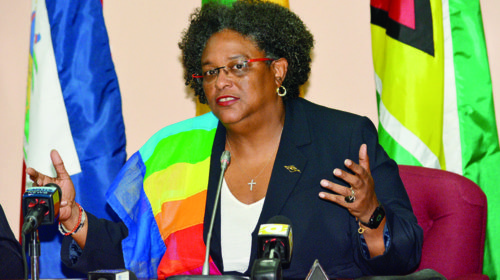
The need for Guyana to aggressively pursue renewable energy while also exploiting its crude oil reservoirs was underscored by Barbados Prime Minister and Caribbean Community (Caricom) Chairperson Mia Mottley during her stopover in Guyana on Monday.
During a press conference at the Caricom Secretariat on Monday, Mottley noted that while Guyana has oil and gas, it must not neglect clean energy initiatives. Mottley admitted that it’s not only a Guyana issue but a region-wide issue.
She pointed out Suriname—which has been an oil producer for some time and recently found more oil adjacent to Guyana’s Stabroek block. Mottley also noted that Jamaica, Grenada and the Bahamas are dealing with oil-related issues as well.
“I would expect that even though Guyana has huge fossil fuel reserves, that it must also be aggressive with respect to its renewable energy. Because as we all know, fossil fuels are non-renewable. And at the same time, you plan out an oil-based economy, you have to have a parallel track for a non-oil-based economy as well. So, suffice it to say there will be a lot of conversations.”
She noted that the region as a whole is known for having some of the most expensive electricity rates while providing Trinidad’s cost of electricity as an example. Mottley noted that as such, efforts must be made to bring down costs for everyone. In fact, Mottley explained that she has held discussions regarding putting energy on the agenda for the next intercessional meeting.
“The Caribbean region remains one of the most expensive when it comes to accessing electricity. We were reflecting on the fact that in Trinidad, the average cost of electricity in the region ranges between 20 cents to 37 cents per kilowatt-hour and Trinidad subsidizes it at 5 cents per kilowatt-hour. Obviously, this is not sustainable.”
“We need a regional response to having a protocol on energy. For many years it was Trinidad as the primary producer of fossil fuels. We had no clear position on other natural resources and renewable energy. We have a policy, but we haven’t put in the Treaty (of Chaguaramas) a framework to deal with it.”
Guyana currently has a number of incomplete small hydro, solar and wind renewable energy projects. There are also plans to bring gas onshore within the next few years, although there is some uncertainty regarding exactly how much gas is in the Stabroek Block.
The Amaila Falls Hydropower Project, which was initiated under the People’s Progressive Party/Civic (PPP/C) Administration, could have been generating about 50 per cent more electricity than the entire Guyana Power and Light (GPL) supply. But the project was scrapped by the coalition administration who had controlled the National Assembly by a one-seat majority after the 2011 elections. Amaila was expected to deliver a steady source of clean, renewable energy that would have been affordable and reliable and was envisioned to meet approximately 90 per cent of Guyana’s domestic energy needs while removing dependency on fossil fuels.
A report from Norwegian firm Norconsult had in fact named the AFHP as the only realistic way for Guyana to achieve an emission-free electricity sector.
Norconsult had noted the merits of the project, such as its completed feasibility study and a higher plant load than the other alternatives. However, the report had recommended the BOOT (Build, own, operate and transfer) public-private partnership model be used. The consultant had urged that an international investor specialising in hydropower be invited to take a majority stake in the project.
The report states, “The only realistic path for Guyana towards an emission-free electricity sector is by developing its hydropower potential. The fastest way forward is to maintain AFHP as the first major step for substituting its current oil-fired generation.”



